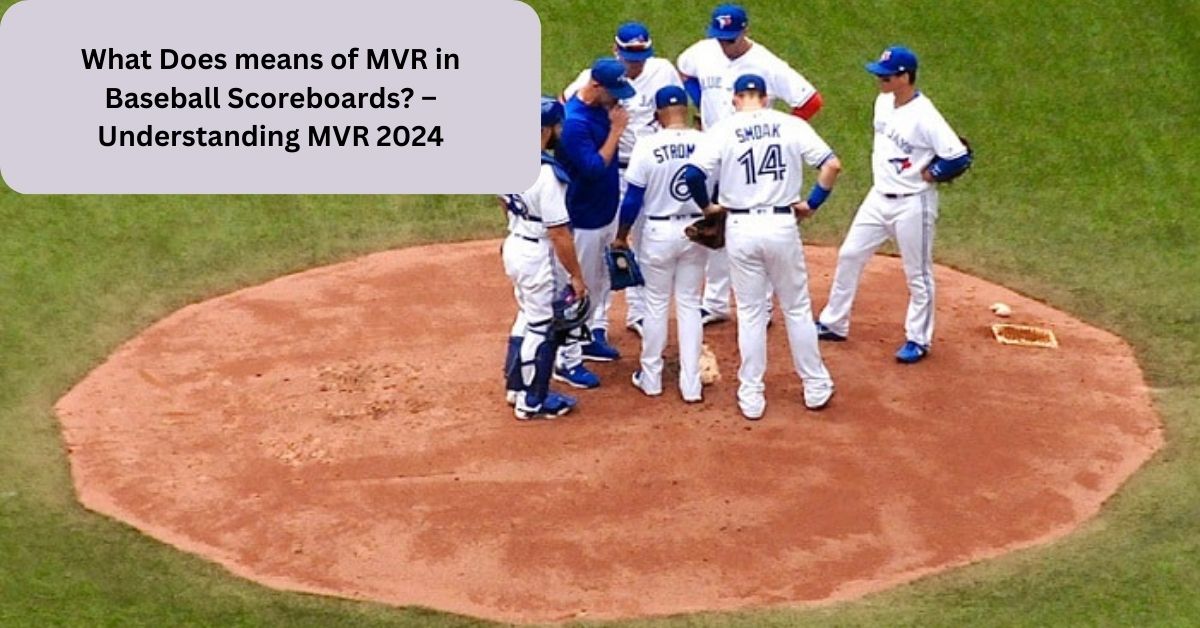When you glance at the expansive baseball scoreboard in the stadium, you’ll often notice the MVR column following the scores for R (runs), H (hits), and E (errors).
Exploring how teams with various MLB standings strategize and adapt their game to secure a win is always intriguing. MVR plays a significant role in this process.
So, what does MVR mean in baseball? This abbreviation stands for Mound Visits Remaining.
Continue reading below as we delve into detail to answer the pressing question, “what is MVR in baseball?
WHat Is MVR in Baseball?
The term “MVR” in baseball stands for Mound Visits Remaining, a concept introduced into the official MLB rules and displayed on the scoreboard since 2018.
Exploring Purpose Of MVR in Baseball:
In baseball, the mound refers to the pitcher’s mound, also known as ‘the hill.’ Mound visits occur when someone approaches the pitcher’s mound during a game. These visitors can include the team’s manager, pitching coach, catcher, infield team, or another pitcher.

The primary purpose of a mound visit is to pause the game for 30 seconds to discuss new strategies or tactics, assess the pitcher’s condition, or make pitching changes.
The Role of MVR Statistic:
The MVR baseball statistic serves to inform the team about the remaining number of mound visits they have until the game concludes.
| MVR Meaning | Mound Visits Remaining |
| Purpose | Indicates the number of remaining mound visits in a game |
| Visitors | Manager, pitching coach, catcher, infield team, or pitcher |
| Function | Allows strategic discussions and assessments during play |
MLB Mound Visit Rules Explained:
Mound visits in Major League Baseball (MLB) are governed by specific rules to maintain fairness and minimize interruptions during the game. Here are the key regulations regarding mound visits:
| Rule | Description |
| Total Visits Allowed | Each team is permitted a maximum of five mound visits during a standard nine-inning game, reduced from six visits in 2018. |
| Time Limit per Visit | The average duration for each mound visit is capped at 30 seconds. |
| Limitation on Managerial Visits | Coaches or managers are restricted to visiting the pitcher once per inning. During the visit, the pitcher must remain on the mound. If the pitcher leaves the mound, they must be replaced. |
| Consequence of Multiple Visits | If the same pitcher is visited by the coaching staff twice in a single inning, they must be replaced. |
| Extra Innings | In games extending beyond nine innings, each team is granted one additional visit per extra inning, which does not necessitate a pitching change. |
| Additional Details | For comprehensive regulations on mound visits, refer to MLB’s Official Baseball Rules. |
Exceptions for Mound Visits in Baseball:
In certain circumstances, exceptions to the standard mound visit rules are allowed to address unexpected or unique situations. These exceptions are typically at the umpire’s discretion and include:
| Exception | Description |
| Pitcher Injury | If the pitcher appears to be potentially injured, the team may request a mound visit to assess their health. |
| Cross-up Between Catcher and Pitcher | In cases of miscommunication or cross-up between the catcher and pitcher, an extra visit is permitted to rectify the situation without penalty. |
| Infielders’ Mound Visit for Cleaning | Team infielders are allowed to approach the mound to use the scraper on the pitcher’s rubber for cleaning purposes, provided they refrain from engaging in communication. This action does not count as a mound visit. |
| Pinch Hitter Called in During Dead Ball | When a pinch hitter is called in by the offensive team during a dead ball situation, team players may gather at the pitching mound without deducting an MVR. |
Understanding Mound Visits in Baseball:
In baseball, a mound visit (MVR) occurs when any member of the team, including coaches and staff, gathers at the pitcher’s mound to discuss strategy, consider a pitch change, or provide mental support to the pitcher.
| Scenario | Description |
| Normal Conversations | Regular discussions between players of the same team do not count as mound visits. |
| Mound Visits During Suspended Play | If a game is suspended while players are on the field, mound visits during the suspension do not count towards the team’s MVR. |
| Unique Rules for Game Delays or Suspensions | – If a game is suspended during or after a mound visit, and the batter is still at bat, the pitcher may be substituted without penalty. – If a rain delay occurs during a mound visit (or after), and the batter is still at bat, the team can make a pitcher substitution. |
Mound Visit Limits in MLB:
In Major League Baseball (MLB), each team is allowed five mound visits during a standard nine-inning game. Additionally, for every extra inning played, each team receives one additional mound visit.

Therefore, the total number of mound visits permitted in a game is the sum of the original five official visits and any extra visits granted for additional innings played.
Also Read: Scaling Your Business with White Label Lead Generation Software
Baseball Abbreviations Explained:
Explore some common baseball abbreviations and their meanings:
| Abbreviation | Definition |
| MVR | Mound Visits Remaining: Indicates the number of visits a team has left to the pitcher’s mound during a game. |
| LOB | Left On Base: Counts the number of players still on base at the end of an inning, reflecting a team’s scoring potential. |
| OPS | On-base Plus Slugging: A combined statistic that measures a batter’s on-base percentage and slugging percentage. |
| E | Errors: Reflects the number of mistakes made by the defensive team during the game. |
| H | Hits: Indicates the number of successful hits by a team’s batters during the game. |
| R | Runs: Represents the number of times a team has successfully scored by reaching home plate. |
These abbreviations are commonly seen on baseball scoreboards, providing key insights into the game’s progress and performance metrics.
Also Read: Navigating On-Call Pay: Essential Information for Employers
Conclusion:
Now you know what MVR in baseball stands for, how many MVR are allowed in a game, and how to track a team’s MVR count. Understanding the rules and exceptions for mound visits beyond the permitted limit of five meetings is essential in baseball.
Baseball is a strategic game where situations can change rapidly, often requiring pitchers to adapt and implement new tactics. Mound visits play a crucial role in every match, facilitating communication and strategy adjustments between players and coaches.
FAQs:
Q. What does MVR stand for in baseball?
MVR stands for Mound Visits Remaining in baseball.
Q. How many mound visits are allowed in an MLB game?
Each team is allowed a maximum of five mound visits during a standard nine-inning game.
Q. What are some common baseball abbreviations and their meanings?
· MVR: Mound Visits Remaining
· LOB: Left On Base
· OPS: On-base Plus Slugging
· E: Errors
· H: Hits
· R: Runs




